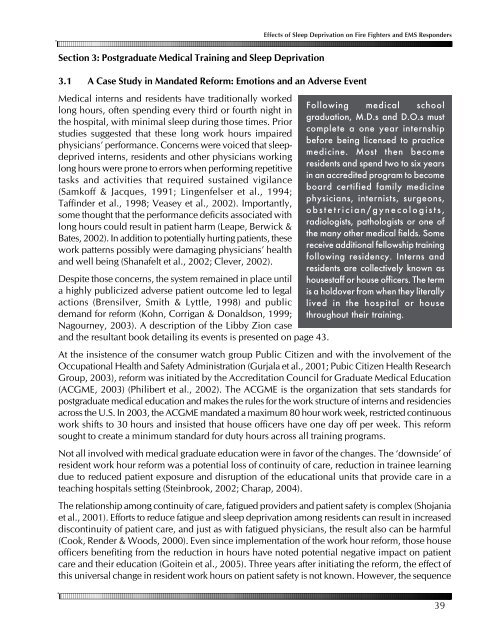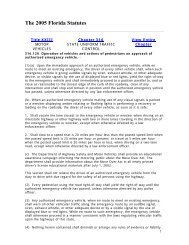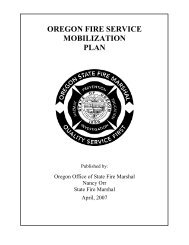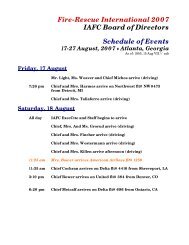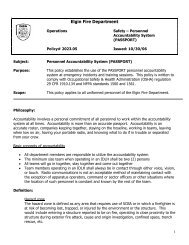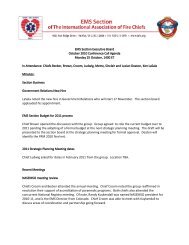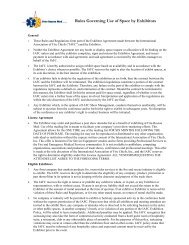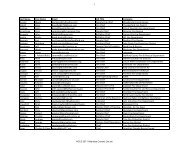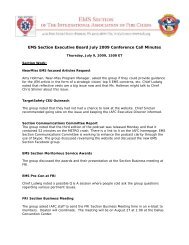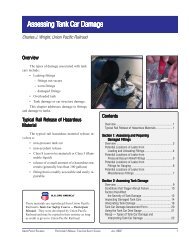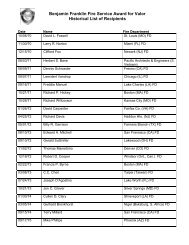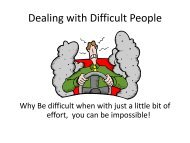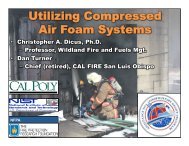Effects of Sleep Deprivation on Fire Fighters and EMS ... - NAEMT
Effects of Sleep Deprivation on Fire Fighters and EMS ... - NAEMT
Effects of Sleep Deprivation on Fire Fighters and EMS ... - NAEMT
You also want an ePaper? Increase the reach of your titles
YUMPU automatically turns print PDFs into web optimized ePapers that Google loves.
<str<strong>on</strong>g>Effects</str<strong>on</strong>g> <str<strong>on</strong>g>of</str<strong>on</strong>g> <str<strong>on</strong>g>Sleep</str<strong>on</strong>g> <str<strong>on</strong>g>Deprivati<strong>on</strong></str<strong>on</strong>g> <strong>on</strong> <strong>Fire</strong> <strong>Fighters</strong> <strong>and</strong> <strong>EMS</strong> Resp<strong>on</strong>ders<br />
Secti<strong>on</strong> 3: Postgraduate Medical Training <strong>and</strong> <str<strong>on</strong>g>Sleep</str<strong>on</strong>g> <str<strong>on</strong>g>Deprivati<strong>on</strong></str<strong>on</strong>g><br />
3.1 A Case Study in M<strong>and</strong>ated Reform: Emoti<strong>on</strong>s <strong>and</strong> an Adverse Event<br />
Medical interns <strong>and</strong> residents have traditi<strong>on</strong>ally worked<br />
l<strong>on</strong>g hours, <str<strong>on</strong>g>of</str<strong>on</strong>g>ten spending every third or fourth night in<br />
the hospital, with minimal sleep during those times. Prior<br />
studies suggested that these l<strong>on</strong>g work hours impaired<br />
physicians’ performance. C<strong>on</strong>cerns were voiced that sleepdeprived<br />
interns, residents <strong>and</strong> other physicians working<br />
l<strong>on</strong>g hours were pr<strong>on</strong>e to errors when performing repetitive<br />
tasks <strong>and</strong> activities that required sustained vigilance<br />
(Samk<str<strong>on</strong>g>of</str<strong>on</strong>g>f & Jacques, 1991; Lingenfelser et al., 1994;<br />
Taffinder et al., 1998; Veasey et al., 2002). Importantly,<br />
some thought that the performance deficits associated with<br />
l<strong>on</strong>g hours could result in patient harm (Leape, Berwick &<br />
Bates, 2002). In additi<strong>on</strong> to potentially hurting patients, these<br />
work patterns possibly were damaging physicians’ health<br />
<strong>and</strong> well being (Shanafelt et al., 2002; Clever, 2002).<br />
Despite those c<strong>on</strong>cerns, the system remained in place until<br />
a highly publicized adverse patient outcome led to legal<br />
acti<strong>on</strong>s (Brensilver, Smith & Lyttle, 1998) <strong>and</strong> public<br />
dem<strong>and</strong> for reform (Kohn, Corrigan & D<strong>on</strong>alds<strong>on</strong>, 1999;<br />
Nagourney, 2003). A descripti<strong>on</strong> <str<strong>on</strong>g>of</str<strong>on</strong>g> the Libby Zi<strong>on</strong> case<br />
<strong>and</strong> the resultant book detailing its events is presented <strong>on</strong> page 43.<br />
Following medical school<br />
graduati<strong>on</strong>, M.D.s <strong>and</strong> D.O.s must<br />
complete a <strong>on</strong>e year internship<br />
before being licensed to practice<br />
medicine. Most then become<br />
residents <strong>and</strong> spend two to six years<br />
in an accredited program to become<br />
board certified family medicine<br />
physicians, internists, surge<strong>on</strong>s,<br />
obstetrician/gynecologists,<br />
radiologists, pathologists or <strong>on</strong>e <str<strong>on</strong>g>of</str<strong>on</strong>g><br />
the many other medical fields. Some<br />
receive additi<strong>on</strong>al fellowship training<br />
following residency. Interns <strong>and</strong><br />
residents are collectively known as<br />
housestaff or house <str<strong>on</strong>g>of</str<strong>on</strong>g>ficers. The term<br />
is a holdover from when they literally<br />
lived in the hospital or house<br />
throughout their training.<br />
At the insistence <str<strong>on</strong>g>of</str<strong>on</strong>g> the c<strong>on</strong>sumer watch group Public Citizen <strong>and</strong> with the involvement <str<strong>on</strong>g>of</str<strong>on</strong>g> the<br />
Occupati<strong>on</strong>al Health <strong>and</strong> Safety Administrati<strong>on</strong> (Gurjala et al., 2001; Pubic Citizen Health Research<br />
Group, 2003), reform was initiated by the Accreditati<strong>on</strong> Council for Graduate Medical Educati<strong>on</strong><br />
(ACGME, 2003) (Philibert et al., 2002). The ACGME is the organizati<strong>on</strong> that sets st<strong>and</strong>ards for<br />
postgraduate medical educati<strong>on</strong> <strong>and</strong> makes the rules for the work structure <str<strong>on</strong>g>of</str<strong>on</strong>g> interns <strong>and</strong> residencies<br />
across the U.S. In 2003, the ACGME m<strong>and</strong>ated a maximum 80 hour work week, restricted c<strong>on</strong>tinuous<br />
work shifts to 30 hours <strong>and</strong> insisted that house <str<strong>on</strong>g>of</str<strong>on</strong>g>ficers have <strong>on</strong>e day <str<strong>on</strong>g>of</str<strong>on</strong>g>f per week. This reform<br />
sought to create a minimum st<strong>and</strong>ard for duty hours across all training programs.<br />
Not all involved with medical graduate educati<strong>on</strong> were in favor <str<strong>on</strong>g>of</str<strong>on</strong>g> the changes. The ‘downside’ <str<strong>on</strong>g>of</str<strong>on</strong>g><br />
resident work hour reform was a potential loss <str<strong>on</strong>g>of</str<strong>on</strong>g> c<strong>on</strong>tinuity <str<strong>on</strong>g>of</str<strong>on</strong>g> care, reducti<strong>on</strong> in trainee learning<br />
due to reduced patient exposure <strong>and</strong> disrupti<strong>on</strong> <str<strong>on</strong>g>of</str<strong>on</strong>g> the educati<strong>on</strong>al units that provide care in a<br />
teaching hospitals setting (Steinbrook, 2002; Charap, 2004).<br />
The relati<strong>on</strong>ship am<strong>on</strong>g c<strong>on</strong>tinuity <str<strong>on</strong>g>of</str<strong>on</strong>g> care, fatigued providers <strong>and</strong> patient safety is complex (Shojania<br />
et al., 2001). Efforts to reduce fatigue <strong>and</strong> sleep deprivati<strong>on</strong> am<strong>on</strong>g residents can result in increased<br />
disc<strong>on</strong>tinuity <str<strong>on</strong>g>of</str<strong>on</strong>g> patient care, <strong>and</strong> just as with fatigued physicians, the result also can be harmful<br />
(Cook, Render & Woods, 2000). Even since implementati<strong>on</strong> <str<strong>on</strong>g>of</str<strong>on</strong>g> the work hour reform, those house<br />
<str<strong>on</strong>g>of</str<strong>on</strong>g>ficers benefiting from the reducti<strong>on</strong> in hours have noted potential negative impact <strong>on</strong> patient<br />
care <strong>and</strong> their educati<strong>on</strong> (Goitein et al., 2005). Three years after initiating the reform, the effect <str<strong>on</strong>g>of</str<strong>on</strong>g><br />
this universal change in resident work hours <strong>on</strong> patient safety is not known. However, the sequence<br />
39


